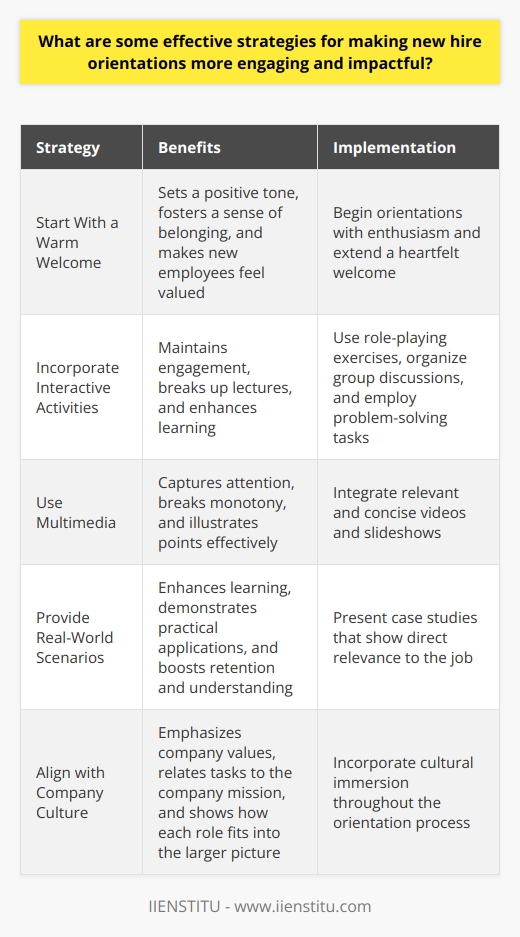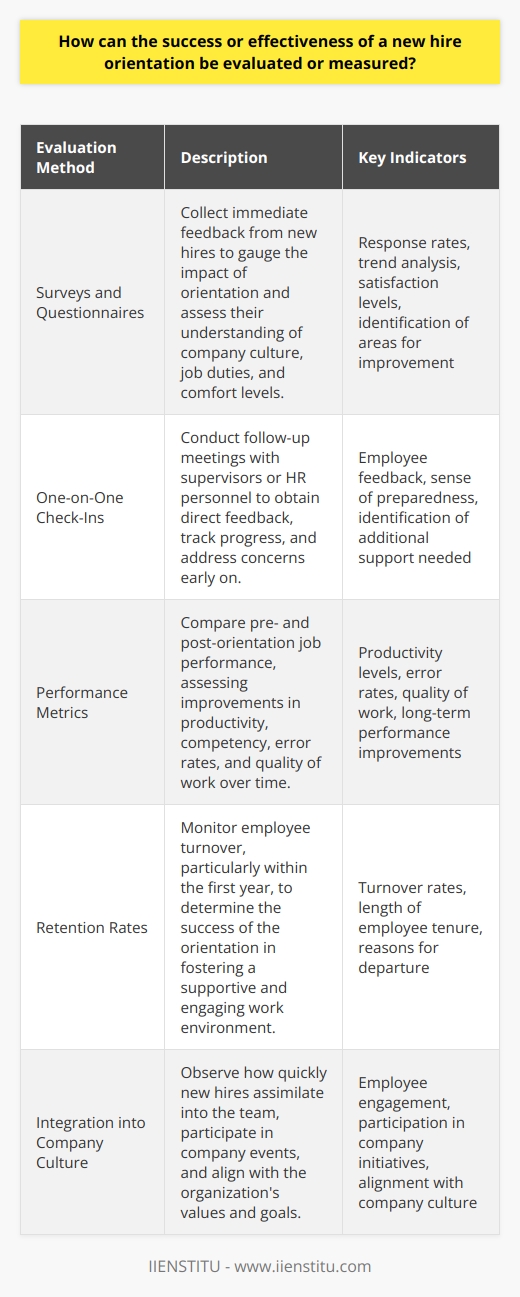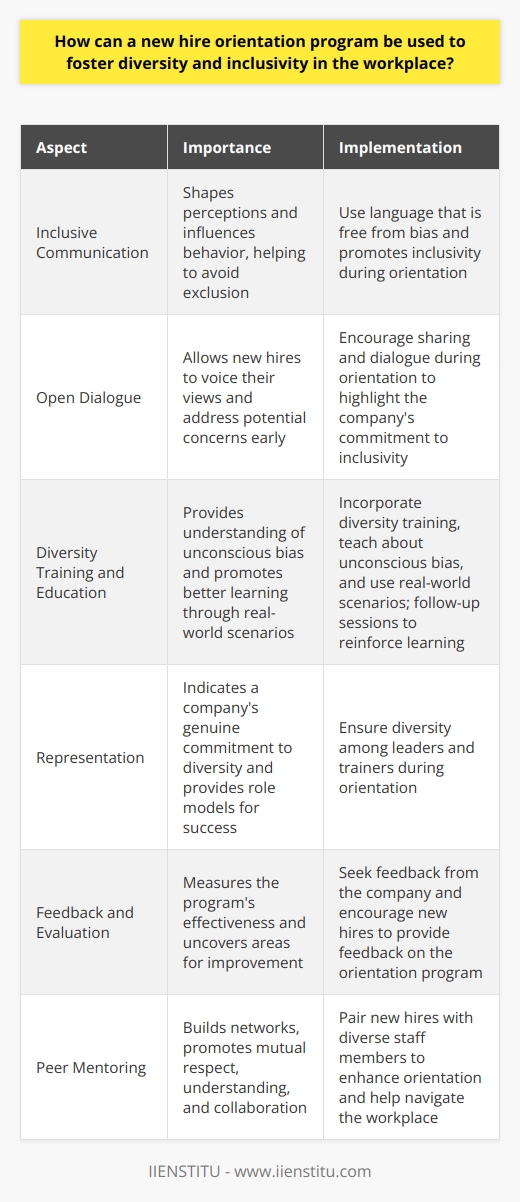
Embarking on a New Journey: The Significance of Effective New Hire Orientation
I still remember my first day at my current company as if it were yesterday. The nerves, the excitement, and the overwhelming rush of new information--it was a whirlwind. But what truly made a difference was the comprehensive and heartfelt orientation program they had in place. This wasn't just a mundane walkthrough of company policies; it was an immersive experience that made me feel valued and prepared.
Starting a new job is more than just a professional shift; it's a significant life event, and how a company welcomes new employees can set the tone for their entire journey within the organization. In this piece, I'd like to share the critical elements of a successful new hire orientation and some personal anecdotes and insights I've gathered over the years. Whether you're an HR professional looking to enhance your onboarding process or a new employee curious about what to expect, I hope my experiences provide valuable perspectives. Plus, I've sprinkled in some references and resources for those who want to dive deeper into the topic.
Critical Elements of a New Hire Orientation
Explanation of the Company Culture and Expectations
One of the most memorable parts of my orientation was the deep dive into the company's culture. Instead of just handing out a manual, they shared real, heartfelt stories about how the company's values came to life in everyday situations. I remember one story about a team that went above and beyond to meet a client's urgent needs, showcasing the company's commitment to customer satisfaction. This wasn't just about understanding policies but connecting with the organization's heart.
I recall a session in which a senior leader recounted a time when the company had to make a tough decision that, while challenging in the short term, ultimately reinforced its commitment to integrity and customer trust. This story resonated with me because it showed that these weren't just words on a wall; they were principles that guided real actions.
For those interested in exploring this further, James M. Kouzes and Barry Z. Posner's book "The Leadership Challenge" delves into how exemplary leaders model the way by aligning actions with shared values (Kouzes & Posner, 2017). It's a thought-provoking read that emphasizes the importance of living and breathing an organization's core principles.
Introduction to the Team and Work Environment
Meeting my new team was both exciting and nerve-wracking. But, the orientation program's facilitation of these introductions made all the difference. Instead of formal meetings, we had a casual lunch where everyone shared something unique about themselves--not just their roles but their hobbies, passions, and even quirky facts.
I learned that my manager was an avid hiker who had scaled several challenging peaks, which immediately gave us common ground since I love the outdoors, too. This personal touch helped break down barriers and fostered a sense of camaraderie from the get-go.
Organize informal meet-and-greet sessions: Casual settings can ease new employees into the team dynamics.
Share personal stories: Encourage team members to share something beyond work to build personal connections.
Assign a buddy or mentor: Having someone to turn to with questions can alleviate initial anxiety.
Tips for Creating a Welcoming Team Environment:
Organize informal meet-and-greet sessions: Casual settings can ease new employees into the team dynamics.
Share personal stories: Encourage team members to share something beyond work to build personal connections.
Assign a buddy or mentor: Having someone to turn to with questions can alleviate initial anxiety.
According to a study by Bauer and Erdogan (2011), effective onboarding practices, including socialization tactics, can lead to higher job satisfaction, organizational commitment, and lower turnover intentions among new hires.
Training and Development Opportunities
One aspect that truly impressed me was how early the company introduced training and development opportunities. They saw me as a long-term investment rather than just filling a current role. During the orientation, they highlighted various certificate courses, online and internal workshops that I could enroll in.
I immediately signed up for a project management course that enhanced my skills and showed me that the company cared about my professional growth. Knowing that your employer supports your ambitions and provides the tools to achieve them is empowering.
Research by Aguinis and Kraiger (2009) emphasizes the benefits of training and development initiatives, including improved individual performance, enhanced organizational effectiveness, and increased innovation and tacit skills.
The Role of Managers and HR in New Hire Orientation
Responsibilities of the Hiring Manager
From my experience, the hiring manager plays a pivotal role in setting the tone for a new hire's journey. My manager didn't wait for formal evaluations to provide feedback; instead, we had regular check-ins where I could ask questions and receive guidance. This open line of communication made me feel supported and confident in my new role.
One practice that stood out was setting clear, achievable short-term goals. It gave me a roadmap and a sense of accomplishment as I checked each milestone. This sense of achievement can be a powerful motivator, driving new employees to perform at their best and contributing to the team's overall success.
In "The First 90 Days," Michael D. Watkins (2013) emphasizes the crucial role of managers in helping new hires transition successfully by providing clarity, resources, and support during the critical initial months.
Importance of HR in Coordinating and Executing Effective Orientations
The HR team is often the unsung hero in the orientation process. They are the architects behind the scenes, ensuring everything runs smoothly. In my case, HR provided a well-organized schedule that balanced informational sessions with interactive activities. They even coordinated with IT to set up all my equipment and access from day one, which isn't always the case in many organizations.
Moreover, they introduced me to the company's wellness programs and employee resource groups, which showcased their commitment to a holistic work environment. This sense of care and support from the HR team can make new employees feel valued and part of a larger, supportive community within the company.
For HR professionals looking to enhance their orientation programs, "Successful Onboarding: A Strategy to Unlock Hidden Value Within Your Organization" by Mark Stein and Lilith Christiansen (2010) offers practical insights and case studies on designing impactful onboarding experiences.
Measuring the Success of New Hire Orientation
Role of Feedback in Evaluating the Effectiveness of the Program
After my orientation, I was encouraged to provide honest feedback about my experience. This wasn't just a token gesture; the company genuinely wanted to know what worked and what could be improved. Sharing my thoughts felt empowering, and I noticed that some of my suggestions were implemented for the next cohort of new hires. Your feedback is not just welcomed; it's integral to the process, making you a key player in shaping the future of the company's onboarding experience.
Anonymous surveys: Allowing for candid responses without fear of repercussion.
One-on-one interviews: Providing a personal touch to understand individual experiences.
Focus groups: Encouraging discussion among recent hires to generate ideas.
Employee retention rates: High turnover shortly after hiring could indicate onboarding issues.
Time to productivity: Measuring how quickly new hires reach expected performance levels.
Engagement scores: Using tools to assess how engaged employees feel after the orientation.
Gathering feedback can be as simple as:
1- Anonymous surveys: Allowing for candid responses without fear of repercussion.
2- One-on-one interviews: Providing a personal touch to understand individual experiences.
3- Focus groups: Encouraging discussion among recent hires to generate ideas.
Metrics for Success
While personal feedback is invaluable, quantifiable metrics prove an orientation program's effectiveness. Companies might look at:
Employee retention rates: High turnover shortly after hiring could indicate onboarding issues.
Time to productivity: Measuring how quickly new hires reach expected performance levels.
Engagement scores: Using tools to assess how engaged employees feel after the orientation.
By combining qualitative and quantitative data, organizations can continuously refine their orientation programs for better results.
Reflecting on my journey, I can attest to the profound impact a well-crafted new hire orientation can have. It's not just about imparting information; it's about weaving new employees into the company's story, making them feel valued and prepared to contribute meaningfully.
Sinek, S. (2009). Start with Why: How Great Leaders Inspire Everyone to Take Action. Penguin Group.
Bradt, G. (2009). Onboarding: How To Get Your New Employees Up To Speed In Half The Time. John Wiley & Sons.
Morgan, J. (2017). The Employee Experience Advantage: How to Win the War for Talent by Giving Employees the Workspaces they Want, the Tools they Need, and a Culture They Can Celebrate. Wiley.
University of Oxford Study on Workplace Learning: Found in academic journals on organizational behavior and employee development.
Academic articles on Employee Onboarding and Engagement Metrics: Accessible through databases like JSTOR and Emerald Insight.
Investing in robust orientation programs pays dividends for organizations in employee satisfaction, retention, and overall performance. By focusing on personal connections, clear expectations, and ongoing support, companies create a foundation for mutual success.
If you're a new hire, I encourage you to fully embrace the orientation process. Ask questions, connect with your peers, and utilize the resources offered. And if you're an employer or HR professional, remember that how you welcome new employees can shape their entire perception of the company.
For those eager to delve deeper, check out "Creative Onboarding Programs: Tools for Energizing Your Orientation Program" by Doris Sims (2011). It's a practical guide filled with innovative ideas and best practices for designing engaging and effective onboarding experiences.
References
Aguinis, H., & Kraiger, K. (2009). Benefits of training and development for individuals and teams, organizations, and society. Annual Review of Psychology, 60, 451-474. https://doi.org/10.1146/annurev.psych.60.110707.163505
Bauer, T. N., & Erdogan, B. (2011). Organizational socialization: The effective onboarding of new employees. In S. Zedeck (Ed.), APA handbook of industrial and organizational psychology, Vol. 3. Maintaining, expanding, and contracting the organization (pp. 51-64). American Psychological Association. https://doi.org/10.1037/12171-002
Kouzes, J. M., & Posner, B. Z. (2017). The leadership challenge: How to make extraordinary things happen in organizations (6th ed.). John Wiley & Sons.
Sims, D. M. (2011). Creative onboarding programs: Tools for energizing your orientation program. McGraw-Hill.
Stein, M., & Christiansen, L. (2010). Successful onboarding: A strategy to unlock hidden value within your organization. McGraw-Hill.
Watkins, M. D. (2013). The first 90 days: Proven strategies for getting up to speed faster and smarter. Harvard Business Review Press.
Frequently Asked Questions
What are some effective strategies for making new hire orientations more engaging and impactful?
Making New Hire Orientations Engaging
Start With a Warm Welcome
First impressions matter greatly. Begin orientations with enthusiasm. Extend a heartfelt welcome. This sets a positive tone. It fosters a sense of belonging. New employees feel valued from the start.
Incorporate Interactive Activities
Interactive elements maintain engagement. Break up lectures with hands-on activities. Use role-playing exercises. Organize group discussions. Employ problem-solving tasks.
Use Multimedia
Visual aids capture attention. Integrate videos and slideshows. They break monotony. Leverage multimedia to illustrate points. Ensure content is relevant and concise.
Provide Real-World Scenarios
Real-world applications enhance learning. Present case studies. They demonstrate practical applications. New hires see direct relevance. This boosts retention and understanding.
Schedule Breaks Appropriately
Frequent breaks prevent information overload. They offer rest and networking opportunities. Breaks combat fatigue. Keep them at regular intervals.
Foster a Two-Way Dialogue
Encourage questions and feedback. Continuous dialogue yields better engagement. It allows clarification. Feedback identifies areas for improvement.
Align with Company Culture
Emphasize company values. Relate tasks to the company mission. Cultural immersion is crucial. Show how each role fits into the larger picture.
Offer Mentoring and Support
Assign mentors to new hires. This provides instant support. It aids in quicker adjustment. Mentors offer guidance. They ease the transition into the company.
Utilize Gamification Techniques
Gamification adds a fun element. It encourages participation. Use leaderboards and reward systems. They spark healthy competition.
Develop Clear Objectives
Outline clear goals for the orientation. Specify what new hires should learn. Define success measures. Clear objectives guide the journey. They align expectations.
In conclusion, gripping orientations trigger beneficial outcomes. They ensure information sticks. They build connections. Implement these strategies for effective orientations. New hires will thank you for a memorable start.

How can the success or effectiveness of a new hire orientation be evaluated or measured?
New Hire Orientation: Measuring Success
Defining Effectiveness
Effectiveness refers to achieving desired goals. In new hire orientation, goals may include increased understanding of company culture or rapid competency in job duties. Effectiveness, thus, aligns with how well new hires integrate and perform.
Evaluation Methods
Surveys and Questionnaires
Immediate feedback helps gauge orientation impact. Surveys provide insights into the employee's perspective. Questions can assess clarity of information and new hire comfort levels. Response rates and trends indicate overall satisfaction and areas needing improvement.
One-on-One Check-Ins
Supervisors or HR personnel can hold follow-up meetings. These allow direct feedback and personal engagement. Conversations can reveal if employees feel they received the necessary tools and knowledge. Consistent check-ins can track progress and address concerns early.
Performance Metrics
Compare pre- and post-orientation job performance. Look for improvements in productivity and competency. Assess error rates and quality of work. Track these metrics over time to see long-lasting effects of the orientation process.
Retention Rates
Monitor turnover, especially within the first year. High retention suggests a successful orientation. It implies new hires felt well-prepared and supported. Conversely, early departures may signal orientation shortfalls.
Integration into Company Culture
Observe how quickly new hires blend with the team. Measure their participation in company events and initiatives. Successful cultural assimilation reflects positively on orientation processes.
Mentor and Peer Feedback
Include insights from assigned mentors or experienced colleagues. Their observations provide another viewpoint on new hire readiness. They can offer feedback on the practical aspects of orientation.
Time-to-Productivity
Record the time it takes for new hires to reach full productivity. Shorter times suggest effective orientation. Compare this to the pre-established benchmarks for expected performance ramp-up.
Continuous Improvement
Iterative Approach
Use findings to refine orientation programs. Feedback loops help create a culture of continuous improvement. Regularly update materials and methods to keep the orientation relevant and impactful.
Adaptation to Different Learning Styles
Different employees have different learning needs. Ensure orientation caters to a variety of styles. Adjustments can help maximize effectiveness for future cohorts.
Alignment with Organizational Goals
Ensure orientation supports broader strategic objectives. Align content and delivery methods with company goals and values. Measure effectiveness not just in isolation but as part of the wider organizational ecosystem.
In conclusion, evaluating new hire orientation calls for a multi-faceted approach. Consider immediate and long-term indicators of success. Regularly collect and analyze data. Refine the process through ongoing feedback. Aim for an orientation that contributes to employee retention, performance, and overall company success.

How can a new hire orientation program be used to foster diversity and inclusivity in the workplace?
New Hire Orientation and Workplace Diversity
The Role of Orientation Programs
Orientation programs serve a critical function. They introduce new hires to the company culture. Additionally, these programs can instill organizational values from day one. Importantly, they must emphasize diversity and inclusivity.
Shaping a Diverse and Inclusive Culture
Diversity covers various human attributes and experiences. These include race, gender, age, and more. Inclusivity involves valuing and leveraging these differences. Together, they foster a healthy workplace environment. Thus, orientation programs must focus on these aspects actively.
Developing an Inclusive Orientation
Communication is key. It starts with the language used during orientation. This language should be inclusive and free from bias. Words shape perceptions. They influence behavior. Therefore, careful word choice can help avoid exclusion.
Encouraging Open Dialogue
Orientation should encourage sharing and dialogue. This allows new hires to voice their views. It also helps in addressing potential concerns early. Dialogue highlights the company's commitment to inclusivity.
Training and Education
- Provide diversity training.
- Teach about unconscious bias.
- Use real-world scenarios for better learning.
This training should not be a one-off. Follow-up sessions are vital. They help reinforce what the new hires learned.
Representation Matters
Representation has an impact. New hires should see diversity in leaders and trainers. This indicates a company's genuine commitment. It also provides role models. Role models show that success does not depend on one’s background.
Feedback and Evaluation
Feedback is a two-way street. The company must seek it. New hires must provide it. Feedback helps measure the program's effectiveness. It also uncovers areas for improvement.
Building Connections
Peer mentoring can enhance orientation. It pairs new hires with diverse staff members. This builds networks and helps in navigating the workplace. Mutual respect grows through such interactions. Understanding and collaboration follow suit.
Continuous Improvement
Finally, orientation is a starting point. It sets the tone for the ongoing journey. The program must evolve with time. Employee needs and societal norms change. The company must adapt accordingly.
Inclusive orientation programs are a crucial investment. They lay the foundation for a diverse and dynamic workforce. The company must commit to practicing what it preaches. Only then can it expect its employees to follow suit.



